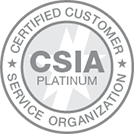A crucial but often overlooked component of your business model is the culture that you create within your company. The first thing to recognize is that it’s something that needs to be thoughtfully designed and nurtured, not something that should be allowed to just happen.
Corporate culture can be described as the shared values, standards, and beliefs that govern the behavior of management and employees. A positive culture that is designed and implemented correctly and consistently can be a powerful force supporting performance excellence and enhancing your competitive advantage. A negative culture can be poisonous.
Here are some thoughts about what you can do to create a culture in your company that will help you be successful. These concepts are as relevant to non-profit organizations and associations as they are to for-profit companies.
Understand the culture that best supports your mission
I firmly believe that the design of your business model is the key to business success. My definition of a business model includes five components:
- Mission—how you will improve the lives of your customers
- Culture—the values, standards, and beliefs that support fulfillment of your Mission
- Operating Process—the day to day methodology used to fulfill the Mission
- Resources—the people, skills, facilities, partnerships etc. that you need to perform the Operating Process
- Financial Formula—the relationship between expenses and revenues that will generate a profit
Culture is a foundational element of your business. You could have a great mission and process, outstanding resources, and a sound financial formula. But if your culture is flawed, everything crumbles to the ground.
A great example of a company with a clear and well-enforced culture is Wal-Mart. I personally believe that their culture has played an enormous role in their incredible success. If you’ve had any experience working with Wal-Mart buyers, you know that they consider their mission to be acting as agents for the consumer to save them money so they can live better. All well and good. But it’s their unique Sam Walton-initiated culture that makes this work so effectively. It dictates, for one thing, maintaining relationships with suppliers that are cooperative, demanding in a fair way, and strictly objective. To that end, in stark contrast with many other retailers, their buyer-salesperson relationships have always been of the arm’s length variety and this has been strictly enforced over the years without exception. Add to that their other cultural attributes like obsessive continuous improvement, merchandising boldness, customer focus, etc. and you have a potent cultural platform on which to build a business.
Include the most important mission-supporting values
Be careful what you choose to include. There are certain values that virtually every company should embrace like integrity, fairness, teamwork, and continuous improvement.
Certain values and policies might stem from the kind of employees you’d like to attract like work flexibility or development opportunities.
And, you might want to include some that differentiate you from your competitors like obsessive customer-centricity or high speed innovation.
What you need is the right mix of cultural elements that best creates the working environment that you believe will best support your mission—but not so many that no one can remember what they all are.
Walk the Talk
There are few things more demoralizing in an organization than leaders who lay out a glorious set of corporate values but then don’t follow them themselves. The CEO and other senior managers need not only to lead the culture creation process but also be its most avid followers. You can talk all you want about the importance of efficiency and timeliness but if you yourself are late for meetings or miss promised deadlines, you’re teaching your staff that that’s acceptable.
And, it’s not enough to just live the values. You need to find ways to continually remind everyone what they are virtually every time you’re talking to your employees or through other forms of communication and events.
Hire people who fit the culture
This is enormously important. Not every employee can flourish in any culture. And a fish out of water will contaminate the atmosphere (literally and figuratively). Part of your recruiting process needs to address cultural fit. Then make sure your culture is explained in detail with explanatory examples during new employee orientation.
And, if you make a mistake and hire someone who doesn’t buy in, act quickly to remove them. This sounds cruel but cultures are crucial and fragile at the same time. Keeping a misfit on board will not do you or them any good.
Align your compensation and rewards system to support your culture
A critical component of culture reinforcement is your overall policy for compensation, feedback, rewards, and punishment too. No matter what you tell your employees your culture is, what gets rewarded and what gets punished sends the definitive message. For example:
- If you want to promote teamwork, your bonus system needs to have at least some team component.
- If you want to encourage innovation and risk-taking, people who make good tries and fail should be praised not punished.
- If you want your managers to think long-term, don’t predicate all compensation on short-term results.
- If you want to see more culture consistent behaviors, praise publicly behaviors that reflect your important values and promote employees who are culture ambassadors.
- If you seek continuous improvement, create a system for creating measurable objectives and reviewing results.
Next Steps
There is a culture that’s a perfect fit for every mission. What you and your key employees need to do is identify the employee attitudes, standards, and behaviors that will support what you are trying to accomplish, document them, and live them.




